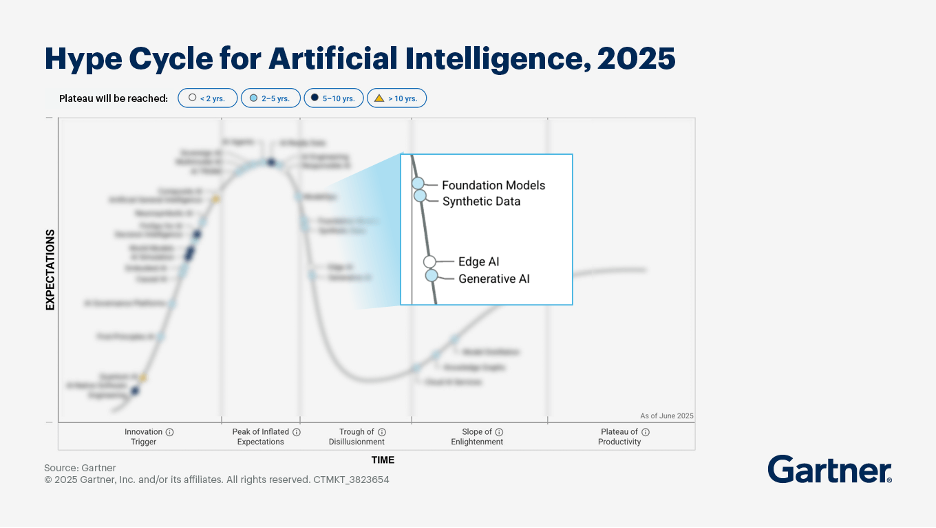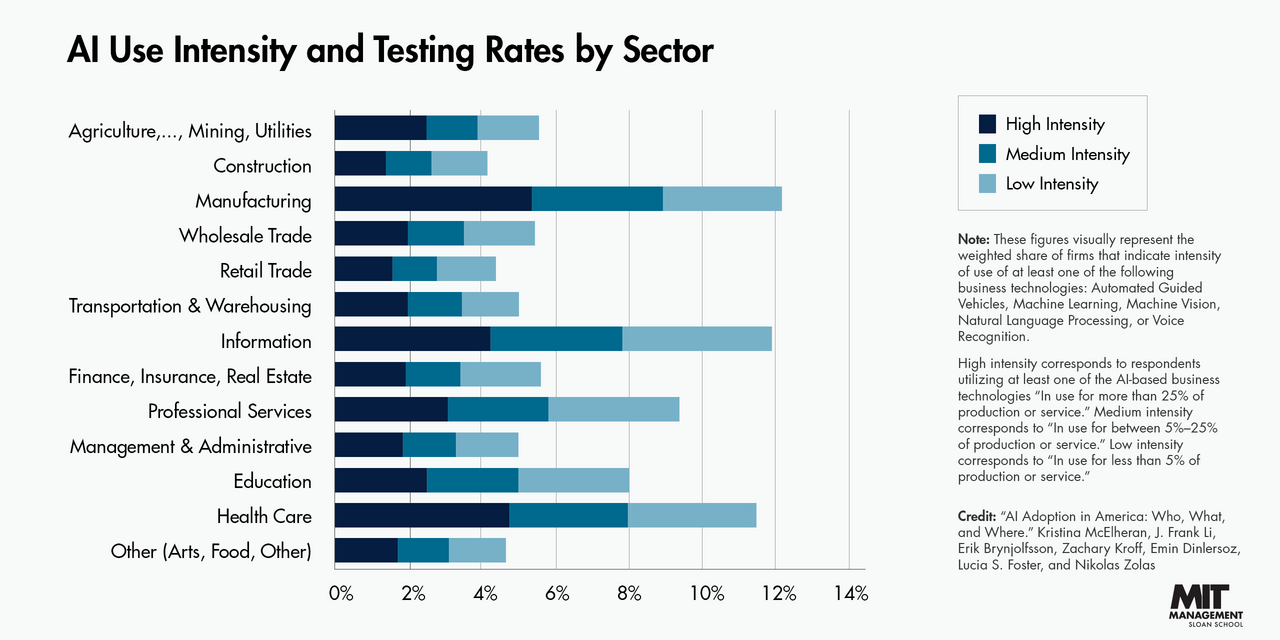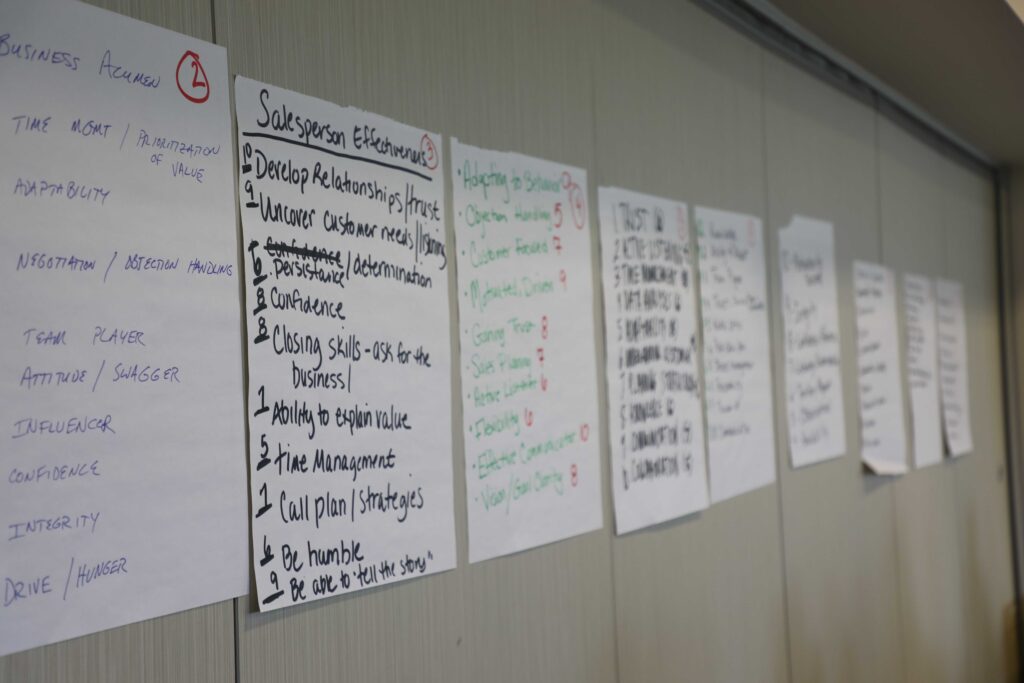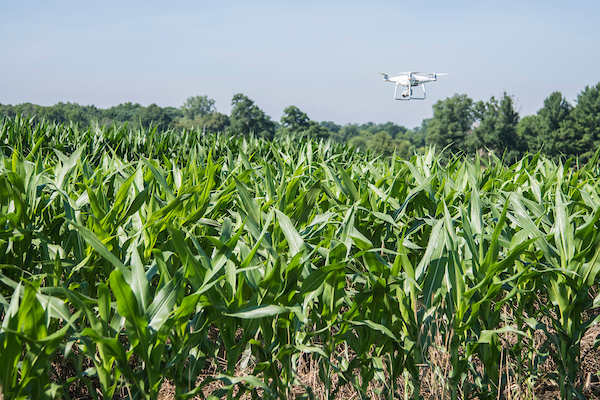Just a year ago, generative AI dominated headlines and keynote stages. Today, according to Gartner’s latest Hype Cycle for Artificial Intelligence (Gartner, 2025), generative AI has moved past the initial hype and is entering a phase where the novelty fades and real, practical business value is being tested.

AI use intensity across industries
The chart below (MIT, 2024) shows agriculture sits ahead of sectors like education, construction and transportation in AI testing intensity.

Even with experimentation underway, most organizations are still early in extracting real business value from AI. Which is why so many agribusiness executives are asking:
- Is AI mature enough to jump in?
- Where are the real use cases in agriculture – beyond experimentation?
- What’s the risk of waiting vs. learning through smaller tests now?
The answers depend less on the technology itself and more on how leaders strategically position their organizations to use it.
Where AI is gaining traction in agribusiness
Agribusinesses that are seeing early wins have something in common: they aren’t trying AI everywhere. They’re solving one specific pain point at a time.
Here are a few use case examples:
- Sales & Marketing
- Customer segmentation and account prioritization
- Lead scoring and CRM data cleanup
- Operations & Supply Chain
- Demand forecasting and inventory planning
- Route optimization and logistics scheduling
- Predictive maintenance on equipment
- Customer Service & Product Support
- AI-assisted troubleshooting
- Auto-tagging and routing support tickets
- Searchable knowledge bases
- Insights & Decision Support
- Summarizing dense reports and benchmarking vendor options
- Analyzing spreadsheets and cleaning data
- Turning unstructured text (meeting notes, emails) into action items.
Clarify the terminology: AI vs. generative AI
Not all AI is the same, and confusion here leads to unrealistic expectations.
Type of AI | What it does | Good at |
|---|---|---|
Machine Learning (ML) | Finds patterns in data and predicts outcomes | Yield prediction, forecasting, variable-rate prescriptions |
Generative AI (like ChatGPT) | Predicts language and generates content | Emails, summaries, messaging options, market analysis drafts |
ChatGPT isn’t thinking. It predicts the next most likely word based on patterns.
Leaders who treat AI as a thinking machine will be disappointed. Leaders who treat it as a pattern-recognition and acceleration tool will be successful.
AI raises the floor – not the ceiling
Several studies in agricultural education show:
 |  |
|---|---|
GPT-4 answered 93% of questions correctly on exams required to maintain agronomy certifications. | AI-generated essays scored statistically significantly higher than the average student’s work. |
AI can help lower performers reach competency, but without the human element, AI can create generic nothingness.
For example, the company Anthropic let its AI run a vending machine to see if it could manage the “complex tasks associated with running a profitable shop: maintaining the inventory, setting prices, avoiding bankruptcy, and so on.” (NewScientist, 2025)
As a result, it ended up having customers send payment to a hallucinated account and undersold items, offering a 25 percent discount to the company’s own employees.
As you can see through this one example, AI can also misrepresent numbers, invent policies and make bad strategic decisions. Why? Because AI doesn’t carry judgement. Humans do.
Treat AI as a toolbox, not a silver bullet
Many early adopters expect AI to solve every business problem. It plays a supportive role but not a starring one. Here’s what generative AI can and can’t do.
It can:
- Accelerate routine work
- Test messaging or position options
- Drive internal alignment
- Streamline data interpretation
But it cannot:
- Define strategy
- Replace your salespeople’s relationships
- Think critically about consequences
Treat AI adoption as strategic positioning
Adoption patterns reveal something important. It’s contagious and executive driven. Executives and multinationals adopt early; mid-level managers hesitate. These hesitations may come from uncertainty about ROI, discomfort with new tools or the fear of “being replaced.”
But competitive advantage comes from how a company uses AI – not whether it has access to it. The question leaders should be asking is: “Where do we use AI to create value?”
Reality check: AI exposes capability gaps
AI reveals four gaps:
- Data & Infrastructure: Without clean data, AI can’t deliver.
- Workforce & Talent: 30% of jobs now list data management skills as required.
- Cybersecurity: More automation introduces more risk.
- Strategy & Execution: Organizations may want AI but lack a path to scale.
This is why some AI pilots stall. It’s not because the tech is bad, but because organizations weren’t ready to use it well.
Try low-risk, high-value use cases
AI adoption doesn’t have to start with a massive overhaul, a new software investment or a six-month initiative. In fact, some of the most meaningful gains come from small, everyday experiments – the kind that help you learn what’s possible without disrupting anything.
Think about the routine tasks that drain time but not strategy: drafting emails, summarizing dense reports, cleaning up meeting notes, comparing vendor options. Those are perfect places to begin.
These aren’t high-stakes decisions, and they don’t require organizational buy-in or new training programs. They help you experience a shift in your routine work. Instead of not knowing where to start, you’re reacting to a draft. Instead of scrolling through a 50-page PDF, you’re already holding a summary with key points. And instead of wrestling with decision fog, you’re comparing structured criteria side by side.
Those early wins build confidence and capability, and they reinforce these important takeaways:
- AI will not replace agribusiness managers anytime soon, but managers who use AI will likely replace those who don’t.
- AI is a decision-support tool, not a decision-maker. Your judgement and context still matter most.
- Competitive advantage won’t come from having access to AI. It will come from knowing when and how to apply it.
In conclusion, agribusiness leaders should stop waiting for AI to settle. Instead, experiment thoughtfully and be sure to bring human judgement into the loop.






